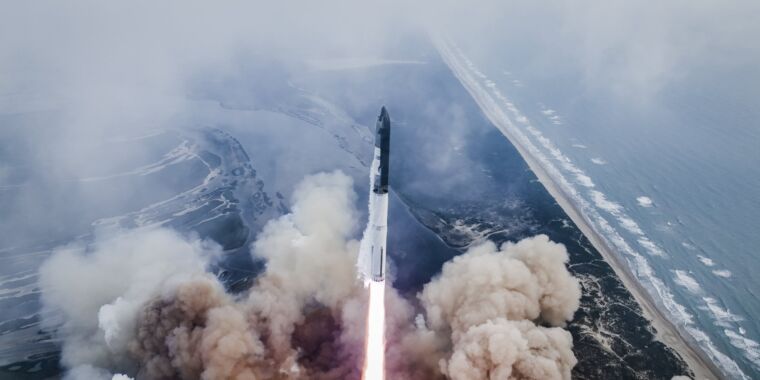SpaceX
Welcome to Edition 6.35 of the Rocket Report! This week has seen several notable rocket failures, with a launch in Japan experiencing issues shortly after liftoff, a rare misstep for China’s Long March rockets, and another Starship flight test. Despite these setbacks, the Starship flight test marked a significant advancement towards operational readiness, with a successful first stage performance and a successful flight of Starship in space.
As always, we value reader submissions and encourage you to share your insights. To ensure you never miss an issue, consider subscribing below to receive updates on small, medium, and heavy-lift rockets, along with a preview of the upcoming launches on the calendar.
Japanese small-lift rocket launch incident
Tokyo-based startup Space One faced a setback this week when its solid-fuel Kairos rocket failed to deliver a satellite into orbit. The 18-meter, 23-ton rocket carrying a mockup of a government spy satellite exploded just seconds after liftoff, leading to its remains falling onto a nearby mountainous area. Despite this setback, Space One remains committed to its goal of conducting 20 launches per year by the end of 2029 and 30 launches in the 2030s.
Live news coverage of the incident captured the aftermath as firefighters worked to extinguish the resulting fire. Fortunately, there were no injuries reported from the explosion, highlighting the resilient spirit of Space One executives in the face of adversity.
Stratolaunch success in deploying Talon-A vehicle
Stratolaunch achieved a significant milestone with the successful deployment of the Talon-A vehicle from its Roc aircraft over the Pacific Ocean. The Talon-A, resembling a mini space shuttle, was intended to reach hypersonic speeds, although it fell short of this goal during the test flight. Powered by the Hadley rocket engine developed by Ursa Major, the TA-1 vehicle showcased the potential for future hypersonic flight advancements.
Ursa Major’s focus on providing propulsion solutions to launch customers has propelled the company into the spotlight, with ongoing development efforts for larger engines like the Ripley. This achievement further solidifies Ursa Major’s position in the rocket propulsion industry.
Stoke Space engine test for Nova rocket
Stoke Space conducted a successful test of the full-size 30-thruster engine designed for the second stage of its Nova rocket. This engine serves as a crucial component of the reusable rocket, with plans to revolutionize space travel through its innovative design. The recent engine test follows a previous test flight on the Hopper 2 prototype vehicle, showcasing the progress towards Nova’s development.
With Nova’s towering height of approximately 30.5 meters, the rocket is poised to undertake a variety of missions, including satellite deployment, scientific experiments in space, and even satellite retrieval or space debris removal. Stoke Space’s ambitious vision for achieving frequent launches, potentially every 24 hours, illustrates the company’s commitment to advancing space exploration.
Image/Photo credit: source url





